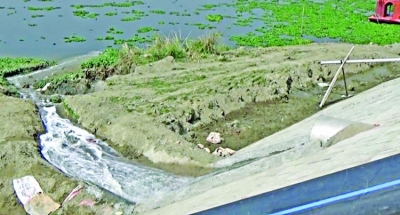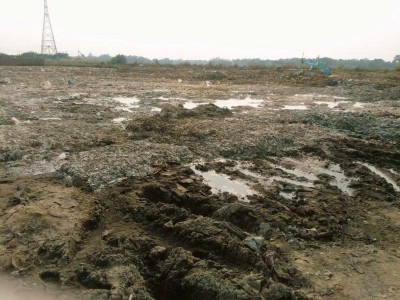
 Bu Sumi Khan
Bu Sumi Khan
Dhaka, Aug 3 : The ingredients of liquid refined tannery waste of Bangladesh Small and Cottage Industries Corporation (BSCIC) follows the standards set by the Environment Department, said KM Ali Azam, Secretary of the Industries Ministry.
The country’s tanned leather exports fell from nearly $300 million in FY 2016 to less than $90 million in present.
To fight additional pressure after Eid-ul-Adha, five bodies were constituted aiming to take all necessary measures after observing the overall conditions, he said.
The Secretary made the remark while visiting the industrial area of the tannery at BSCIC of Savar here on Sunday and said already it is fully functional without control of CETP monitoring.
“We managed persistent water supply and electricity connection and also inputted sufficient manpower and security for tannery industry,” he added.
The Ministry of Industries and the BSCIC have stepped up efforts to tackle some of the problems of the central effluent treatment plant CETP.
BSCIC has assigned more engineers to make the CETP fully functional, with a major focus on the chrome recovery unit.
It has also launched an effort to secure land-registration papers for TIE tannery owners to help them with their financing. Other development partners are working with the business associations on sustainability reporting, human resources development, and developing a knowledge base of global markets and trends.
Besides, to boost leather exports to the US and Europe, the industry must obtain certification from the Leather Working Group (LWG) demonstrating compliance with those markets’ labour and environmental standards, said experts.
Standards compliance must be seen, therefore, as an integral part of Bangladesh’s national investment in the leather industry.
To achieve this compliance, harmonious relations between workers and owners will also be required.
Workers and owners need to recognize their common interest in obtaining LWG certification.
There are several causes for this malaise, including poor marketing, an unskilled workforce, and lack of financing, but chief among them have been exploitive labour conditions and destructive environmental practices that have brought international criticism and sanctions.
The leather sector is one of the oldest industries in Bangladesh, and tanneries are the dominant employer, accounting for 92 per cent of all leather workers.
As a source of national export earnings, leather is second only to ready-made garments, and Bangladesh leather exports account for 10 per cent of world demand.
But the industry has been troubled in recent years, especially the tannery sub-sector.
For decades, pollution from tanneries at the main industrial site in Dhaka poured into the Buriganga River, wiping out aquatic life and forcing the city to rely heavily on groundwater for washing and drinking.
But in 2017, culminating a government campaign that began in 2001, the tanners were forced to move their factories to the newly built Tannery Industrial Estate (TIE) located in Savar.
Of the 220 factories at the Dhaka site, roughly 90 per cent of all tanneries in the country, some 123 completed the move and are currently operating in Savar.
It was hoped that the tannery move would increase exports in the leather sector by bringing the industry into compliance with destination-market requirements, but the hasty, disorganized, and incomplete construction of the TIE appears to have thwarted this hope.
To prevent the dangerous pollution that occurred at the old Dhaka site and bring the industry into better compliance with customer environmental requirements, the new location includes a central effluent treatment plant (CETP), able to treat 30,000m3 of liquid effluents a day, and additional facilities for chrome recovery, water treatment, and sludge treatment.
But some planned capabilities are not yet installed, and the CETP is not yet running at full efficiency, with the result that sludges are now dumped in an open yard, and untreated water is regularly dumped into the neighbouring Dhaleshwari River, causing severe pollution.
The local community complained that the Dhaleshwari River has become “unusable” and “toxic” since the tanneries arrived.
They reported itching and other skin problems from the use of the river water. Farmers, who make up 75 per cent of the people in the riverbank villages, can no longer use the river water for irrigation, and have had to install motor-driven tube wells, increasing their costs substantially.
The village social life has also changed. Previously, people of all ages used to swim and bathe in the river and wash their cattle there.
For the workers, housing, transportation, and food are more expensive in Savar. Most workers are still temporary, with no benefits or allowances for their higher expenses. Most of them work without formal employment agreements, factory identity cards, or provisions for leaves of absence. Women receive no maternity leave.
Most workers lack personal protective equipment and must operate tools and machinery without adequate safety measures. Most tanneries, apart from a few larger ones, do not follow national or international standards for storing, transporting, or using harmful chemicals and workers and supervisors commonly suffer from diseases of the skin and lungs, headaches, diarrhea, and fatigue.
The Department of Inspection for Factories and Establishments (DIFE) is responsible for inspecting these factories and enforcing compliance with health and safety regulations, but with just two inspectors for the whole tannery estate, a lack of appropriate communications channels, and a general atmosphere of mistrust, the agency is finding it challenging to perform its oversight role, says local community people.
Disclaimer: This story is auto-generated from IANS service.

